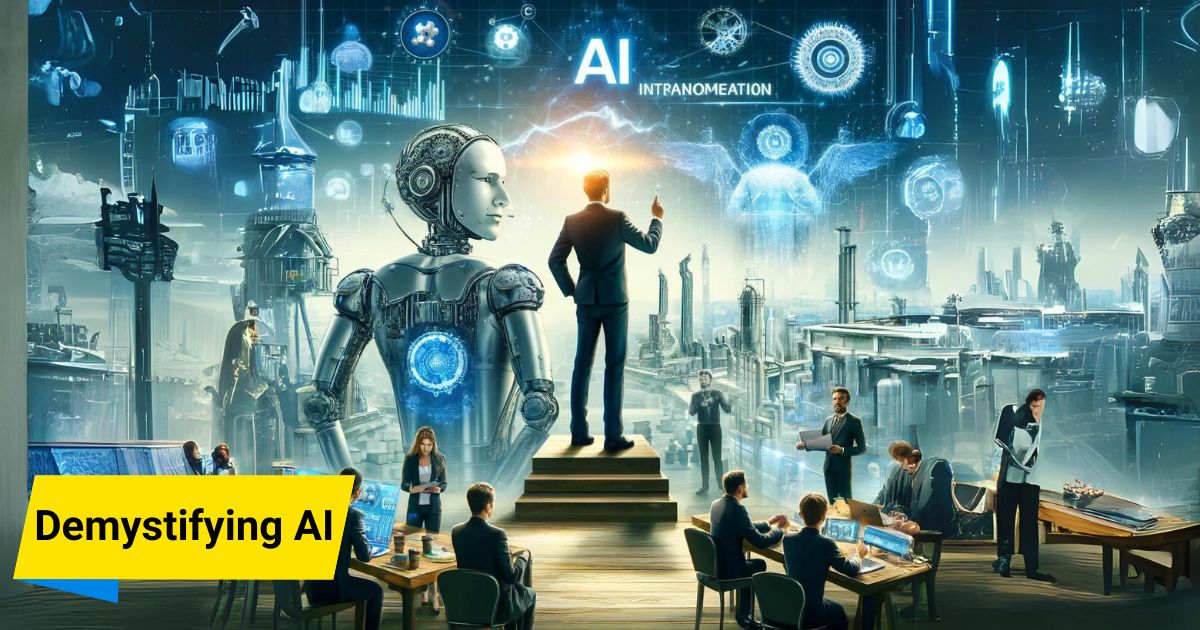Stuck in the Stone Age of Business While Your Competitors Embrace the Future?
But fear not! This guide is your key to unlocking the power of AI for your business. Here we are explaining AI for entrepreneurs concepts in simple terms. We’ll translate the complex world of AI into simple, actionable steps, dispelling the myths and anxieties surrounding this transformative technology.
Whether you’re worried about job displacement, unsure how to navigate implementation challenges, or simply curious about AI’s potential, this guide will equip you with the knowledge and confidence to embrace the future.
Get ready to discover how AI can streamline operations, boost efficiency, and propel your business toward groundbreaking innovation. Let’s ditch the fear and dive into the exciting world of AI, together!
Imagine your competitor unveils a revolutionary new product, developed with the help of cutting-edge Artificial Intelligence (AI).
Suddenly, your once-reliable business model feels like a dusty relic from a bygone era. Feeling overwhelmed by the technical jargon and unsure where to start?

You’re not alone. Many business leaders find themselves in this very situation, watching AI transform industries at an unprecedented pace.
Explaining the AI Magic: What is AI and How Does it Work?
Before we delve into the exciting possibilities AI offers for businesses, let’s establish a solid foundation. Artificial Intelligence (AI) might sound like something out of science fiction, but the core concept is surprisingly simple.

Imagine a machine that can learn and adapt over time, mimicking some aspects of human cognitive functions like problem-solving and decision-making. That, in essence, is AI/
Now, let’s unpack this further and explore the different types of AI that are revolutionizing various industries.
1. Machine Learning (ML)
This is a subfield of AI where algorithms learn from data without explicit programming.
Think of it like this: you show a child pictures of cats and dogs. Over time, the child learns to distinguish between the two.
Similarly, machine learning algorithms can analyze vast amounts of data, identify patterns, and make predictions based on those patterns.
For instance, an ML algorithm can analyze customer purchase history to recommend personalized products or predict future demand for specific items.
There are different types of machine learning algorithms, each suited for specific tasks. Some common examples include:
Supervised Learning
Here, the algorithm is trained on labeled data (data where the desired outcome is already known).
For example, an email spam filter might be trained on millions of emails labeled as “spam” or “not spam.”
This allows the algorithm to learn the characteristics of spam emails and identify future spam messages more accurately.
Unsupervised Learning
In this approach, the algorithm analyzes unlabeled data and discovers hidden patterns.
Imagine analyzing customer browsing behavior on an e-commerce website.
Unsupervised learning can identify clusters of customers with similar browsing patterns, allowing for targeted marketing campaigns.
By leveraging the power of machine learning, businesses can automate tasks, gain valuable insights from data, and make data-driven decisions for improved efficiency and growth.
2. Deep Learning
This is a subfield of machine learning inspired by the structure and function of the human brain.
Deep learning algorithms use artificial neural networks, which are complex interconnected layers that process information similarly to how the human brain does.
These networks can learn from vast amounts of data, including images, text, and speech.
Deep learning excels at tasks like image recognition, natural language processing, and speech recognition.
For example, deep learning algorithms power facial recognition software used for security purposes or enable virtual assistants like Siri or Alexa to understand and respond to your voice commands.
In the business world, deep learning can be used to analyze customer sentiment from social media posts or automate image and video editing processes.
As you can see, AI isn’t just a single technology, but a collection of powerful tools with diverse applications.
By understanding the different types of AI and their capabilities, businesses can unlock a world of possibilities for innovation and growth.
Unleashing the Potential: How AI Can Supercharge Your Business
Imagine a world where tedious tasks are handled effortlessly, customer interactions are personalized and seamless, and data-driven insights guide strategic decision-making.
This isn’t a futuristic fantasy – it’s the reality within reach for businesses that embrace Artificial Intelligence (AI). By leveraging AI’s capabilities, companies can unlock a treasure trove of benefits, transforming operations, enhancing customer experiences, and driving growth.

Let’s explore some of the key ways Demystifying AI can supercharge your business:
1. Increased Efficiency and Automation
Repetitive tasks that drain valuable resources are prime candidates for AI automation. AI-powered Robotic Process Automation (RPA) can handle tasks like data entry, form processing, and scheduling, freeing human employees to focus on higher-level cognitive tasks requiring creativity and critical thinking.
Additionally, AI can automate data analysis, generating reports and identifying trends much faster than traditional methods.
This allows businesses to make data-driven decisions in real time, optimizing processes and maximizing efficiency.
For instance, an AI-powered customer service chatbot can answer frequently asked questions, troubleshoot basic issues, and even schedule appointments, freeing up human customer service representatives to handle more complex inquiries.
In the manufacturing sector, AI-powered predictive maintenance can analyze sensor data to predict equipment failures before they occur, minimizing downtime and saving businesses significant costs.
These are just a few examples of how AI’s automation capabilities can streamline operations and boost productivity for businesses across industries.
2. Enhanced Customer Experience
In today’s competitive landscape, exceptional customer experience is paramount. AI empowers businesses to personalize interactions and cater to individual customer needs.
AI-powered chatbots can provide 24/7 customer support, answer product-related inquiries, and even offer personalized product recommendations based on a customer’s past purchases and browsing behavior.
Natural Language Processing (NLP) allows AI systems to understand and respond to human language, enabling businesses to create chatbots that can hold natural conversations with customers.
Additionally, AI can analyze customer sentiment from social media posts and online reviews, allowing businesses to identify areas for improvement and address customer concerns proactively.
By providing personalized and responsive customer experiences, businesses can build stronger customer relationships, foster loyalty, and drive sales.
3. Improved Decision-Making
Data is the lifeblood of modern businesses, but turning data into actionable insights can be a challenge. AI excels at analyzing vast amounts of data, identifying patterns, and predicting future trends.
Businesses can leverage AI-powered analytics to gain valuable insights into customer behavior, market trends, and competitor activity.
This data-driven approach empowers businesses to make informed decisions about product development, marketing strategies, and resource allocation.
For example, AI-powered market research can analyze customer demographics, social media sentiment, and online search trends to identify emerging customer needs and preferences.
This allows businesses to stay ahead of the curve and develop products and services that resonate with their target audience. Additionally, AI can be used for predictive analytics, forecasting future sales trends or identifying potential risks.
By leveraging AI’s data analysis capabilities, businesses can make strategic decisions with greater confidence, leading to improved performance and a competitive edge.
As you can see, the benefits of Demystifying AI for businesses are far-reaching. From automating tasks to personalizing customer experiences and making data-driven decisions, AI has the potential to revolutionize how businesses operate and compete in the ever-evolving marketplace.
The Road to AI Adoption: Challenges and Considerations for Businesses
The potential benefits of Artificial Intelligence (AI) for businesses are undeniable. However, the journey to successful AI adoption isn’t without its hurdles.

Several challenges and considerations need to be addressed to ensure responsible and effective Demystifying AI implementation. Let’s explore some key factors to navigate on the path to AI success:
1. Data Security and Privacy Concerns
AI thrives on data, but data security and privacy are paramount concerns. Businesses must ensure they have robust data security practices in place to protect sensitive customer information.
Additionally, it’s crucial to comply with data privacy regulations like GDPR (General Data Protection Regulation) and CCPA (California Consumer Privacy Act) when collecting and using customer data for AI applications.
Building trust with customers is essential. Businesses should be transparent about how they collect, store, and use customer data for AI development.
Providing customers with control over their data and offering clear opt-in/opt-out mechanisms are crucial for building trust and ensuring ethical AI practices.
2. Lack of Skilled Personnel
Successfully implementing and managing AI solutions requires a skilled workforce with expertise in areas like data science, machine learning, and AI engineering.
The current talent pool for these specialized skills is limited, which can pose a challenge for businesses.
AI skills development is critical. Businesses can invest in training programs to upskill their existing workforce or partner with AI experts to bridge the talent gap.
Additionally, fostering a culture of continuous learning within the organization is essential to keep pace with the rapid advancements in AI technology.
3. Algorithmic Bias
AI algorithms are only as good as the data they’re trained on. If the data used to train AI systems is biased, the resulting algorithms can perpetuate or even amplify those biases.
This can lead to unfair outcomes, such as discriminatory hiring practices or biased loan approvals.
Mitigating Algorithmic Bias requires a proactive approach. Businesses need to ensure the data used to train AI models is diverse and representative of the target population.
Additionally, implementing fairness checks throughout the AI development process and using techniques like bias detection algorithms can help identify and address potential biases within AI systems.
4. Explainability and Transparency
Understanding how AI systems arrive at decisions is crucial for building trust and ensuring responsible AI development.
However, some AI algorithms, particularly deep learning models, can be complex and opaque, making it difficult to explain their decision-making processes.
Explainable AI (XAI) is an emerging field that aims to make AI models more transparent and interpretable.
XAI techniques can help businesses understand how AI systems arrive at decisions, identify potential biases, and ensure that AI solutions are aligned with ethical principles.
By addressing these challenges and considerations, businesses can navigate the path to successful Explaining AI adoption.
Responsible and transparent AI development is not just an ethical imperative but also a key factor in building trust with customers and ensuring the long-term success of AI initiatives.
From Concept to Action: Your Roadmap to Explaining AI for Your Business
Understanding the immense potential of AI is just the first step.
For business leaders, the real question is: how do we leverage this powerful technology to achieve tangible results?
This section serves as your roadmap to Demystifying AI and implementing successful AI solutions within your organization.

By following these key steps, you can turn the promise of AI into a reality for your business.
1. Conduct a Business Needs Assessment
Before diving headfirst into AI implementation, it’s crucial to identify the areas where AI can add the most value to your business. Conduct a thorough business needs assessment.
Analyze your current operations, identify repetitive tasks, and pinpoint areas where data analysis can be improved. Consider the challenges your business faces and explore how AI solutions might address those challenges.
For instance, a manufacturing company might identify production line inefficiencies as a key area for improvement. AI-powered predictive maintenance can analyze sensor data to predict equipment failures before they occur, minimizing downtime and saving the company significant costs.
Similarly, a customer service department might be overwhelmed by a high volume of inquiries. AI-powered chatbots can handle basic inquiries, freeing up human representatives for more complex customer interactions.
By conducting a thorough needs assessment, you can ensure your AI investments are targeted and aligned with your overall business goals.
2. Start Small and Pilot AI Projects
The world of AI can be vast and complex. Instead of embarking on a large-scale AI implementation right away, consider starting small with pilot projects.
Focus on specific, well-defined tasks where the value proposition of AI is clear. This allows you to test the waters, assess the feasibility of AI solutions, and gain valuable insights before scaling up.
Pilot projects also offer an opportunity to identify potential challenges and refine your approach. For instance, you might pilot an AI-powered lead generation tool for your marketing team.
The pilot project allows you to assess the effectiveness of the AI tool in identifying high-quality leads and adjust parameters as needed.
Additionally, pilot projects can help build buy-in and enthusiasm for AI within your organization by showcasing the tangible benefits it can deliver.
By taking a measured approach and starting small, you can set yourself up for long-term success with AI implementation.
3. Invest in Data Infrastructure and Data Governance
AI thrives on data, but the quality and accessibility of your data are paramount. Investing in a robust data infrastructure is essential for successful AI implementation.
This includes establishing a centralized data storage system, ensuring data quality and consistency, and implementing data security measures.
Data governance is another crucial aspect. It involves establishing clear policies and procedures for data collection, storage, and usage.
This ensures that data is used responsibly and ethically, complying with relevant data privacy regulations.
By prioritizing data infrastructure and data governance, you lay the foundation for reliable and secure AI operations.
The journey to Explaining AI for your business continues in the next section, where we’ll explore building the right team and focusing on responsible AI development.
We’ve established the importance of identifying business needs, starting small with pilot projects, and investing in data infrastructure.
Now, let’s delve into the human element of successful AI implementation: building the right team and fostering a culture of responsible AI development.
4. Building a Team with the Right Skills or Partnering with AI Experts
Successfully implementing AI solutions requires a skilled workforce.
Ideally, your team should possess a combination of expertise in areas like data science, machine learning, AI engineering, and domain-specific knowledge of your industry.
However, the current talent pool for these specialized skills is limited.
For many businesses, the answer might lie in upskilling their existing workforce.
Investing in training programs to equip employees with the necessary AI skills can bridge the talent gap and empower your team to be active participants in the AI journey.
Partnering with AI experts is another viable option. Consulting with external AI specialists can provide the necessary expertise and guidance for successful AI implementation.
These experts can assist with project planning, model development, and ongoing maintenance of AI solutions.
Whether you choose to upskill your team or partner with external experts, the key is to ensure you have the necessary skills and resources in place to navigate the complexities of AI development.
Key Takeways – Explaining AI For Enterpreneurs
By embracing these key takeaways, you can navigate the exciting world of AI with confidence. Remember, the table below summarizes the key steps to Demystifying AI for your business:
| Key Takeaway | Description |
| Conduct a Business Needs Assessment | Identify areas where AI can add the most value. |
| Start Small and Pilot AI Projects | Test the waters and gain valuable insights. |
| Invest in Data Infrastructure and Data Governance | Ensure reliable and secure AI operations. |
| Build a Team with the Right Skills or Partner with AI Experts | Upskill your workforce or partner with external specialists. |
| Focus on Responsible AI Development and Ethical Considerations | Build trust and ensure AI is used ethically |
| Foster a Culture of Continuous Learning | Stay updated on the latest advancements in AI. |
| Collaboration is Key | Break down silos and leverage diverse expertise. |
Frequently Asked Questions
1. Is AI going to take over all our jobs?
Unlikely. AI will automate tasks, but is likely to augment human capabilities and create new job opportunities.
2. How much does it cost to implement AI?
Costs vary depending on the project scope. AI offers a potential return on investment (ROI) and cost-saving benefits.
3. What skills do I need to prepare my workforce for AI?
Critical thinking, problem-solving, and data analysis skills will be crucial for working alongside AI.
Conclusion: Unveiling the Future with AI
The world of Artificial Intelligence (AI) may seem complex, but its potential to transform your business is undeniable.

By following the steps outlined in this guide, you can unlock a treasure trove of opportunities to streamline operations, enhance customer experiences, and drive innovation. This journey doesn’t have to be daunting. With a strategic approach and a commitment to continuous learning, you can harness the power of AI and propel your business into the future.
Remember, AI is a powerful tool, but it’s the human element that determines its impact. Foster a culture of collaboration, prioritize responsible AI development, and embrace continuous learning to ensure AI empowers your workforce and unlocks its full potential within your organization.
Take the first step today and embark on your journey to Demystifying AI for a future filled with growth and success.
Unleash the full potential of AI in your organization! Our comprehensive guide explores the latest advancements in AI innovation and equips you with the knowledge to make informed decisions. Learn more: The Future of AI Innovation: Trends & Challenges
